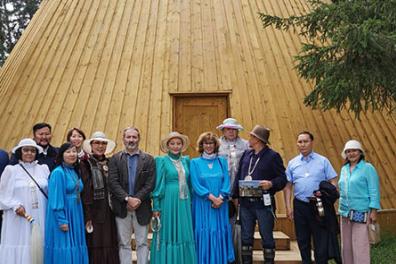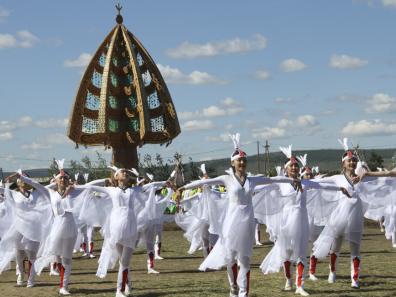Turkic languages of the Sakha Republic (Yakutia)

History of the Yakut people
There are many theories on the origin of the Yakuts, but all researchers consider the Turkish origin of the Yakuts as the fundamental basis. In particular I.V. Konstantinov, like A.P. Okladnikov[1]. and S.A. Tokarev[2] had written: "At the end of the last millennium and in the first centuries of our era, under the onslaught of the Huns occupying Transbaikalia, the tribes originating from Mongolia and Transbaikalia, the Uyghurs and the Huns, established themselves in the Baikal region among the local tribes. This consolidation became the nucleus of a nascent Turkic-speaking population, which from the 6th century onwards became known as the Kurykan and Guligan."
The author writes that the Kurykans are the closest ancestors of the Yakuts. When, in the 10th century, the Khitan Mongol tribes drove the Uyghurs out of Mongolia and into the Altai, the Mongol tribes, living with the Kurykans, assimilated some of the Turks, initiated wars with the Kirghiz of Yenisei, the Khoro Tumats, and from that moment on, the rescue migration of the Kurykans to the northern territories began. The resettlement was completed in the 15th century when the ancestors of the Yakuts reached the Lena lands, assimilating some of the Yukaghirs and Evenks and moving some north. In his research, Konstantinov believes that by the time of the Turkic resettlement, which took place between the 12th and 13th centuries, the Yakut language, the ancient Turkic language, had already developed. The date of formation of the ancient Yakut language can be attested as early as the 5th - 6th century CE.
Geography of Yakutia
Yakutia is located in the north-east of Russia: it's a very large region, almost three million km2, and very sparsely populated due to its extreme climatic conditions (around one million individuals in total). More than half of this population is made up of non-natives, mainly Russians (localized in the 17th century), Belarusians, Ukrainians, Tatars, Buryats and just about every nationality from the former USSR. The rest of the population is local: the Yakuts or Sakhas, localized in the 14th century, speaking Yakut (Sakha).
The name Yakut was given by the Russians, Sakha is the title used by the people, these two terms are used at the same time to name the Republic, the ethnic group and the language. The titular ethnic group, which gave its name to the republic, comprises 466,492 individuals (49.9% - 2010), concentrated mainly in the central ulousses (regions).
The Yakut language
It is part of the Uyghur-oguz subgroup (according to N.A. Baskakov's classification) and belongs to the "northeastern" group of Turkic languages.
The modern Yakut language is widespread in the Sakha Republic (Yakutia), where, along with Russian, it is the state language (and, according to the republic's constitution, is called the Sakha language - from the Yakuts' proper name), in the Taimyr Autonomous Okrug (Dolgano-Nenets) and in some other regions of Eastern Siberia and the Far East. Yakut is spoken not only by the Yakut ethnic group, but also by representatives of a number of other peoples.
In the past, the Yakut language played the role of a regional language of inter-ethnic communication in northeast Siberia. 65% of Yakuts are fluent in Russian; the number of speakers is estimated at around 450,000 (All-Russian Population Census 2010).
Yakut literature
The Yakut literary language was formed under the influence of folklore language in the late 19th - early 20th century, based on central dialects. Yakut words first appeared in a book published in 1692 by the Dutch traveler N. Witsen. Translated missionary literature has been published since the 19th century (the first book appeared in 1812).
Later, in the 18th - early 19th centuries, lists of Yakut words were published in Cyrillic and Latin. Several writing systems were used (all on a Cyrillic basis); above all missionary writing, which was used to publish mainly religious literature. Until the 1920s, various alphabets based on the Cyrillic alphabet were used, in particular the alphabet of Academician O.N. Bötlingk, compiled in 1851, with which scientific publications and the first periodicals were published, and the alphabet of Bishop Dionys (D. V. Khitrov), compiled in 1858 and used in Church publications.
In 1917, a Yakut student, S. A. Novgorodov, compiled an alphabet based on international phonetic transcription, the writing being based on the Latin alphabet. S.A. Novgorodov's alphabet was introduced in 1922.
In 1929, a unified Turkish alphabet (Yanalif) based on the Latin alphabet was approved. Thus, between 1930 and 1940, a Latin-based script was used, and in 1939-40 it was decided that the Yakut alphabet would be based on the Cyrillic alphabet with a few additional letters.
The Yakut alphabet is based on the Cyrillic alphabet.

Yakut dialects. Dolgan
There are three groups of dialects: Western (left bank of the Lena: Vilyui and northwestern dialects), Eastern (right bank of the Lena: central and northeastern dialects) and the Dolgan dialect (Taimyr and Anabar region of the Sakha Republic), which is spoken by the small Dolgan people and is sometimes considered a separate language.
Dolgan is a Turkish language influenced by the indigenous languages of the north. It is widespread in the south and southeast of the Taimyr municipal district of the Krasnoyarsk territory in Russia, as well as in the Anabar (Ulus) region of Yakutia. The number of speakers is around 1054. The Dolgan people developed in the 19th - early 20th century on the basis of Evenks (of the Tungus group), Yakuts, local Evenks, individual Enet families and so-called tundra peasants who emigrated from the Lena and Olenek rivers.
The Brockhaus and Efron encyclopedic dictionary, published in the late 19th - early 20th century, notes that "some of the Yakuts moved to the Yenisei province in the Turukhansk territory, where they managed to completely engulf the Dolgans, a small Tungus tribe, just like the Russians, abandoned in the remotest corners of the Yakutsk territory".
Like the Chuvash language, Yakut and Dolgan are located on the geographical periphery of the Turkic-speaking world and differ greatly (by Turkic family standards) from the other languages included within it.
In phonetics, the Yakut language is characterized by the preservation of primary long vowels and diphthongs, which have disappeared in most Turkic languages.
In grammar - immutable 1- and 2-person personal pronouns, a rich case system (in the absence of a common and local Turkic genitive - a unique feature of the Yakut language), a variety of ways of expressing the direct object and a few other characteristics.
Syntax remains typically Turkic. The specificity of the Yakut language in the field of vocabulary is very significant, which is associated with numerous borrowings from Mongolian, Evenk and Russian languages; the Dolgan dialect (language) was particularly influenced by the Evenk language.
The active vocabulary of the Yakut language contains around 2,500 words of Mongolian origin. As for Russian borrowings, there were already over 3,000 in pre-revolutionary times, and some borrowings have preserved words that are no longer actively used in the Russian language itself, for example, araspaannya 'name' from the Russian nickname or solkuobai 'ruble' from the Russian rouble.... In the language of the press, the share of Russian borrowings reaches 42%.
The transmission and teaching of Yakut
The Yakut language is one of the best-studied Turkic languages. Its first fundamental description ("On the Yakut language") was by the Sanskritologist O.N. Bötlingk (published in German in St. Petersburg in 1851; in 1990 the work was published in Russian translation). Subsequently, the work of E.K. Pekarsky (Dictionary of the Yakut language, 1907-1930), V.V. Radlov ("The Yakut language in its relation to other Turkic languages", 1908), D. Khitrov, S.V. Yastremsky, later L.N. Kharitonov, E.I.Ubryatova, N.E. Petrov, P.A. Sleptsov and other researchers and continues by modern scientists.
In the 21st century, education is provided in the Yakut language, including in higher education (Yakut and Turkic philology and culture), periodicals, various publications are published, radio and television programs are produced. Data for 2010, presented in the republican newspaper "Kyym", show that out of 478,085 Yakuts (Sakha), 450,140 speak their native language. However, in recent years, the number of Yakuts abandoning their mother tongue has increased; bilingualism is maintained, mainly at the expense of the rural population. Alongside the psychological problems that contribute to mother-tongue abandonment, in towns and urban-type agglomerations, the development of bilingualism is artificially or naturally (voluntarily) constrained.
For example, the city of Yakutsk lacked national schools; the Yakut language as a separate subject was studied only in the so-called national schools No. 2, No. 14, No. 26, No. 38, No. 17, nor were there enough "Yakut" nursery schools. In the absence of national kindergartens, due to the social limitations of the sphere of use of their mother tongue, many parents were forced to teach their children only the Russian language. Yet Russian-speaking parents and Russians in general were not opposed to learning the spoken Yakut language, which was included in the school curriculum in the post-perestroika period.
In recent years, under pressure from the local population in the cities, "Yakut classes" have been opened in almost all schools. But in the 21st century, indicators of Yakut language knowledge and quality are declining, as a result of globalization and the development of cyberspace. As for the Dolgan language, it is almost forgotten...
Izabella Borisova
Associate Professor, Ph.D., Associate Professor at the Institute of Foreign Philology and Regional Studies of the North-Eastern Federal University, (Republic of Sakha (Yakutia) Yakutsk)
e-mail: View e-mail
[1] Okladnikov A.P. Istoricheskiy put narodov Yakutii. - Yakutsk, 1943. P.100.
[2] Tokarev S.A. Ocherk istorii yakutskogo naroda. - Moskau, 1940. P.247.
Photo at top of page:
